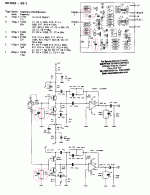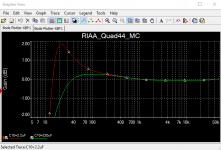Hello,
I grew up with the 'English sound" but then when I moved to the US I sort of went the American way. Since I retired and had more time to listen to music I realized that I was not happy with my system. For me it is about the music. I believe that sound reproduced by British equipment is more tonally accurate and would say that bass extension has never been a priority in most of the British products and neither for me.
So I decided to sell my pair of Aerial 10Ts speakers and purchased a pair of QUAD ESL63 and had them rebuilt, my third pair in a 35 year period. In between I had other brands. I also bought a QUAD 405-2 which I think will match the 63s perfectly even though my Electrocompaniet amp is very good.
Trying to keep my system British all the way I found a 44 preamp but it does not have an MC input module. I am using a Denon DL-103R with my Linn/Ittok.
There are two 44 boards for sale on ebay/Germany but I do not see any switches to adjust the input impedance like the switches in my Klyne 6LX3/P. The seller does not understand English well so he cannot help.
I need help, any recommendations?
Best regards,
Horacio
I grew up with the 'English sound" but then when I moved to the US I sort of went the American way. Since I retired and had more time to listen to music I realized that I was not happy with my system. For me it is about the music. I believe that sound reproduced by British equipment is more tonally accurate and would say that bass extension has never been a priority in most of the British products and neither for me.
So I decided to sell my pair of Aerial 10Ts speakers and purchased a pair of QUAD ESL63 and had them rebuilt, my third pair in a 35 year period. In between I had other brands. I also bought a QUAD 405-2 which I think will match the 63s perfectly even though my Electrocompaniet amp is very good.
Trying to keep my system British all the way I found a 44 preamp but it does not have an MC input module. I am using a Denon DL-103R with my Linn/Ittok.
There are two 44 boards for sale on ebay/Germany but I do not see any switches to adjust the input impedance like the switches in my Klyne 6LX3/P. The seller does not understand English well so he cannot help.
I need help, any recommendations?
Best regards,
Horacio
Last edited:
Thanks but it is for the QUAD 34 not 44.
This is what it looks like but it is possible that these are older boards. I think the metal can transistors were used in very early versions. Probably as at that time there were the one only available as very low noise devices.
This is what it looks like but it is possible that these are older boards. I think the metal can transistors were used in very early versions. Probably as at that time there were the one only available as very low noise devices.
Attachments
Schematic on page 21 of the service manual -- i don't have the new issue of "The Art of Electronics" at hand (lists popular transistors by noise level), but there are some nice TO-92 transistors from Zetex and a DIP packageThatcorp (That340 -- matched P and N pairs) that would work in the same space.
http://www.amplimos.it/images/Quad 44 Service Data.pdf
http://www.amplimos.it/images/Quad 44 Service Data.pdf
> I do not see any switches to adjust the input impedance
If Jack's schematic is correct....
You "switch impedance" by changing parts on the PCB. (Or by buying different sub-model modules, but that is no longer an option.)
If you like nominal 300uV sensitivity, you simply change R1 R2.
For extra precision, C1 and C2 may be changed.
If you run multiple cartridges of similar output, R1R2C1C2 can be on a (high quality!) switch or a plugin-module.
If you need 100uV sensitivity, the list of changes grows. R13 R14 made smaller to boost gain, but that seems to ripple-through the NFB network. Obviously all these values were well-considered and should be followed. Obviously 300uV/100uV switching is a nightmare.
The BC440 transistor is known to me, though long ago. Data says 2A and hFE 40-250. If we sort-off the lowest-hFE units this will be a fine low-Z microphone input device. At the lower Z of MC windings, even the low-end hFE devices won't hiss much.
Other devices are now more common, but they tend to a similar spec. A "maximum" current FAR-FAR higher than a few mA implies low parasitic resistance and low congestion in the crystal. A high hFE leads to a broader range of high impedances at which it can give near-theoretical low hiss; may not matter with low-low source impedances.
Metal can or plastic blob is surely indifferent. There's no heat and the environment is benign. The crystal inside is what counts. I'm sure QUAD tested not only several likely types but several batches of each type to find good types, and further tested each device for excess hiss.
If Jack's schematic is correct....
You "switch impedance" by changing parts on the PCB. (Or by buying different sub-model modules, but that is no longer an option.)
If you like nominal 300uV sensitivity, you simply change R1 R2.
For extra precision, C1 and C2 may be changed.
If you run multiple cartridges of similar output, R1R2C1C2 can be on a (high quality!) switch or a plugin-module.
If you need 100uV sensitivity, the list of changes grows. R13 R14 made smaller to boost gain, but that seems to ripple-through the NFB network. Obviously all these values were well-considered and should be followed. Obviously 300uV/100uV switching is a nightmare.
The BC440 transistor is known to me, though long ago. Data says 2A and hFE 40-250. If we sort-off the lowest-hFE units this will be a fine low-Z microphone input device. At the lower Z of MC windings, even the low-end hFE devices won't hiss much.
Other devices are now more common, but they tend to a similar spec. A "maximum" current FAR-FAR higher than a few mA implies low parasitic resistance and low congestion in the crystal. A high hFE leads to a broader range of high impedances at which it can give near-theoretical low hiss; may not matter with low-low source impedances.
Metal can or plastic blob is surely indifferent. There's no heat and the environment is benign. The crystal inside is what counts. I'm sure QUAD tested not only several likely types but several batches of each type to find good types, and further tested each device for excess hiss.
Attachments
I am using a Denon DL-103R that has an output of 0.25 mV. Output impedance is 14 Ohms.
Klyne recommends that most low output MC cartridges be loaded with as high a load as is practical. Cartridges with a generator impedance higher than 10 Ohms should be loaded at a nominal 47K Ohms. This is the way my Klyne is set up right now.
Cheers,
Horacio
Klyne recommends that most low output MC cartridges be loaded with as high a load as is practical. Cartridges with a generator impedance higher than 10 Ohms should be loaded at a nominal 47K Ohms. This is the way my Klyne is set up right now.
Cheers,
Horacio
Last edited:
- Status
- This old topic is closed. If you want to reopen this topic, contact a moderator using the "Report Post" button.
- Home
- Source & Line
- Analogue Source
- QUAD 44 MC card

![quad-44-m12542b-moving-coil-disc-input-module[3080].jpg](/community/data/attachments/521/521362-7860329c8e83a17464b8fca42402bc09.jpg)

